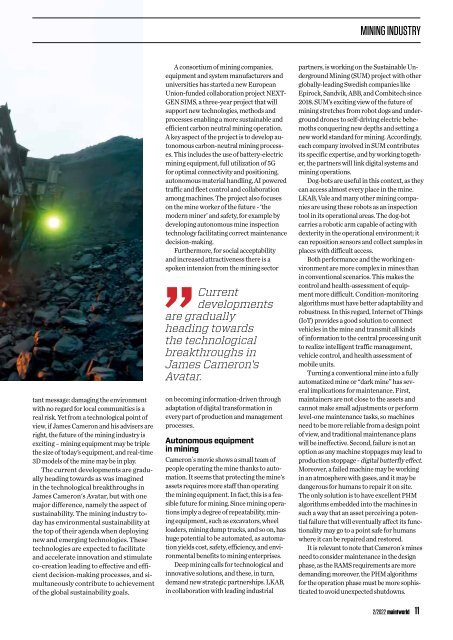Maintworld Magazine 2/2022
- maintenance & asset management
- maintenance & asset management
Create successful ePaper yourself
Turn your PDF publications into a flip-book with our unique Google optimized e-Paper software.
MINING INDUSTRY<br />
tant message: damaging the environment<br />
with no regard for local communities is a<br />
real risk. Yet from a technological point of<br />
view, if James Cameron and his advisers are<br />
right, the future of the mining industry is<br />
exciting – mining equipment may be triple<br />
the size of today’s equipment, and real-time<br />
3D models of the mine may be in play.<br />
The current developments are gradually<br />
heading towards as was imagined<br />
in the technological breakthroughs in<br />
James Cameron's Avatar, but with one<br />
major difference, namely the aspect of<br />
sustainability. The mining industry today<br />
has environmental sustainability at<br />
the top of their agenda when deploying<br />
new and emerging technologies. These<br />
technologies are expected to facilitate<br />
and accelerate innovation and stimulate<br />
co-creation leading to effective and efficient<br />
decision-making processes, and simultaneously<br />
contribute to achievement<br />
of the global sustainability goals.<br />
A consortium of mining companies,<br />
equipment and system manufacturers and<br />
universities has started a new European<br />
Union-funded collaboration project NEXT-<br />
GEN SIMS, a three-year project that will<br />
support new technologies, methods and<br />
processes enabling a more sustainable and<br />
efficient carbon neutral mining operation.<br />
A key aspect of the project is to develop autonomous<br />
carbon-neutral mining processes.<br />
This includes the use of battery-electric<br />
mining equipment, full utilization of 5G<br />
for optimal connectivity and positioning,<br />
autonomous material handling, AI powered<br />
traffic and fleet control and collaboration<br />
among machines. The project also focuses<br />
on the mine worker of the future - ‘the<br />
modern miner’ and safety, for example by<br />
developing autonomous mine inspection<br />
technology facilitating correct maintenance<br />
decision-making.<br />
Furthermore, for social acceptability<br />
and increased attractiveness there is a<br />
spoken intension from the mining sector<br />
Current<br />
developments<br />
are gradually<br />
heading towards<br />
the technological<br />
breakthroughs in<br />
James Cameron's<br />
Avatar.<br />
on becoming information-driven through<br />
adaptation of digital transformation in<br />
every part of production and management<br />
processes.<br />
Autonomous equipment<br />
in mining<br />
Cameron´s movie shows a small team of<br />
people operating the mine thanks to automation.<br />
It seems that protecting the mine's<br />
assets requires more staff than operating<br />
the mining equipment. In fact, this is a feasible<br />
future for mining. Since mining operations<br />
imply a degree of repeatability, mining<br />
equipment, such as excavators, wheel<br />
loaders, mining dump trucks, and so on, has<br />
huge potential to be automated, as automation<br />
yields cost, safety, efficiency, and environmental<br />
benefits to mining enterprises.<br />
Deep mining calls for technological and<br />
innovative solutions, and these, in turn,<br />
demand new strategic partnerships. LKAB,<br />
in collaboration with leading industrial<br />
partners, is working on the Sustainable Underground<br />
Mining (SUM) project with other<br />
globally-leading Swedish companies like<br />
Epirock, Sandvik, ABB, and Combitech since<br />
2018. SUM’s exciting view of the future of<br />
mining stretches from robot dogs and underground<br />
drones to self-driving electric behemoths<br />
conquering new depths and setting a<br />
new world standard for mining. Accordingly,<br />
each company involved in SUM contributes<br />
its specific expertise, and by working together,<br />
the partners will link digital systems and<br />
mining operations.<br />
Dog-bots are useful in this context, as they<br />
can access almost every place in the mine.<br />
LKAB, Vale and many other mining companies<br />
are using these robots as an inspection<br />
tool in its operational areas. The dog-bot<br />
carries a robotic arm capable of acting with<br />
dexterity in the operational environment; it<br />
can reposition sensors and collect samples in<br />
places with difficult access.<br />
Both performance and the working environment<br />
are more complex in mines than<br />
in conventional scenarios. This makes the<br />
control and health-assessment of equipment<br />
more difficult. Condition-monitoring<br />
algorithms must have better adaptability and<br />
robustness. In this regard, Internet of Things<br />
(IoT) provides a good solution to connect<br />
vehicles in the mine and transmit all kinds<br />
of information to the central processing unit<br />
to realize intelligent traffic management,<br />
vehicle control, and health assessment of<br />
mobile units.<br />
Turning a conventional mine into a fully<br />
automatized mine or “dark mine” has several<br />
implications for maintenance. First,<br />
maintainers are not close to the assets and<br />
cannot make small adjustments or perform<br />
level-one maintenance tasks, so machines<br />
need to be more reliable from a design point<br />
of view, and traditional maintenance plans<br />
will be ineffective. Second, failure is not an<br />
option as any machine stoppages may lead to<br />
production stoppage - digital butterfly effect.<br />
Moreover, a failed machine may be working<br />
in an atmosphere with gases, and it may be<br />
dangerous for humans to repair it on site.<br />
The only solution is to have excellent PHM<br />
algorithms embedded into the machines in<br />
such a way that an asset perceiving a potential<br />
failure that will eventually affect its functionality<br />
may go to a point safe for humans<br />
where it can be repaired and restored.<br />
It is relevant to note that Cameron´s mines<br />
need to consider maintenance in the design<br />
phase, as the RAMS requirements are more<br />
demanding; moreover, the PHM algorithms<br />
for the operation phase must be more sophisticated<br />
to avoid unexpected shutdowns.<br />
2/<strong>2022</strong> maintworld 11
















